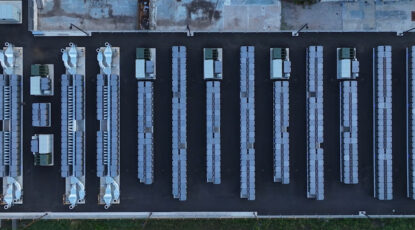Today’s digital economies power more businesses, communities, and cities around the globe than ever before; the demand for power to keep them running is rising along with it.
This is especially true in India, one of the world’s fastest-growing economies, where energy-intensive industries such as mining, manufacturing, oil and gas, software, and aviation are blossoming.
However, India’s economic growth has matured faster than the country’s ability to generate enough power to supply it. The result is a country-wide power dilemma. A growing dependence on reliable power to keep businesses running has resulted in increased use of dirty energy sources like coal-based power generation. Coal-fired plants generate about 72% of India’s electricity.
These sources worsen air quality and still do not meet the growing demand for power, leaving businesses apprehensive about their ability to keep the lights on for crucial operations.
The 2018 Global Competitiveness Report ranked India 80th among 137 economies for electricity supply reliability. The World Bank reported that India loses approximately 4% GDP due to power sector distortions that impact human health and business productivity; it also estimated that eliminating power shortages could prevent $22.7 billion a year in business losses.
Independence from Dirty and Unreliable Power Sources
India’s use of dirty power sources including coal and diesel impact air quality and public health. Burning these fuels produces harmful air pollutants such as mercury, sulfur dioxide (which contributes to acid rain), and particulate matter that creates smog and contributes to respiratory illness.
According to the Health Effects Institute, exposure to fine particulate matter from coal-powered plants contributed to 82,900 deaths in 2015. Bengaluru’s pollution levels in particular are at three times the World Health Organization’s safety limit and there are 14 known areas in Bengaluru that have harmful particulate matter levels exceeding the national standards by a significant margin.
In response, India has made strides expanding clean energy sources, becoming one of the top renewable producers globally. India has an installed renewable energy capacity of about 80 gigawatts (GW) and ambitious plans to achieve 500 GW by 2030.
Although renewables produce the cleanest form of power, there are insufficient resources to power an economic powerhouse such as India with renewables alone. As Bloom Energy has recognized in its work in the United States, Japan, and Korea, there is a critical need for baseload power generated by a resilient fuel supply to keep the economy growing.
That’s why, in addition to its renewable energy plans, India has set a goal to increase its power derived from natural gas from 6% to 15% by 2030.
Natural gas-based power enables India to sustain its rapid pace of economic growth by improving power reliability while also protecting citizens’ health by decreasing the rates of dangerous air pollutants and greenhouse gas emissions.
The Essential Role of Government in the Transition to Natural Gas
At a media roundtable discussion on accelerating India’s transition to natural gas, former Chairman and Managing Director of GAIL (India’s leading natural gas company), Bhuwan Chandra Tripathi, emphasized the significance of the transition. “It’s encouraging to see India’s vision to be a gas-based economy given the country’s growing energy needs. It is pivotal for India to increasingly look at sustainable ways of generating power as it grows.”

Bloom Energy Chief Technology Officer Venkat Venkataraman, former GAIL Chairman and Managing Director Shri Bhuwan Chandra Tripathi, Gail Gas Ltd Chief Executive Officer A K Jana, Mr. J.P. Misra, General Manager, Gas Business of Indian Oil (IOCL), and Ms. Garima Singh, Senior Manager, Energy and Environment of USISPF explore ways to encourage more fuel cell projects in India at a press event in Bengaluru in August 2019.
The government is taking steps to build out natural gas infrastructure. In 2018, the U.S.-India Strategic Partnership Natural Gas Task Force launched with the mission to look at ways the U.S. can help accelerate adoption of natural gas in India.
“The U.S.-India Gas Task Force is focused on stimulating demand for natural gas in India as well as on grid strengthening, to power India’s economy. The Task Force is appreciative of GAIL’s support in developing a growing network of LNG distribution across the country,” said Garima Singh, Senior Manager of Energy and Environment for the U.S. India Strategic Partnership Forum, at the roundtable.
India has already built four LNG terminals, essential for importing natural gas, and plans to add 11 more. There are also 29,000 km of gas trunk pipelines in operation or approved.
A.K. Jana, Chief Executive Officer of GAIL, highlighted advancements the company has made, “GAIL has made significant progress in building a scalable distribution platform for gas with 53% of the country already covered.”
Bloom Energy Is Collaborating to Offer Reliable Power with Flagship Development
As part of the Task Force’s efforts, Bloom Energy, alongside real estate developer Atelier Global, and India’s leading natural gas companies GAIL (India) Limited and Indian Oil Corporation, announced a new flagship commercial real estate development offering clean, reliable power to businesses with operations in Bangalore.

Rendering of Whitefield Tower business-hospitality development and Bloom Energy Server installation in Bengaluru, India.
The Whitefield Tower development is a truly collaborative project; it will be powered by Bloom Energy Servers, built by Atelier, and provided with natural gas by GAIL. This marks the first natural gas project deployed since the launch of the Task Force.
Bloom Energy’s technology is the perfect solution for the Whitefield Tower because it uses solid oxide fuel cells to electrochemically convert the energy in natural gas to electricity. The process generates electricity without combustion, emitting virtually none of the criteria pollutants or smog-forming pollutants that degrade India’s air quality.
Bloom technology also reduces stress on India’s resources. Tony Kunnel, Owner of Atelier D’Arts & Architecture, emphasized “Two vital assets – land and water – play an extensive role in traditional power generation. Even generating solar power requires a fair amount of land and water for cleaning and maintaining the panels. Natural gas-based power using Bloom Energy’s on-site fuel cells protects scarce resources, freeing up land for more vital uses such as agriculture.”
Because Bloom Energy’s technology runs 24 hours a day, 365 days a year, it reduces the need for dirty backup power and decreases greenhouse gas emissions. It also eliminates the need for expensive and unreliable transmission and distribution infrastructure by providing personalized on-site electricity. This is important in India because more than 20% of electricity was lost in transmission and distribution in 2016 — a much higher loss rate than elsewhere in the world.
While Bloom Energy Servers are widely deployed by Fortune 100 companies at more than 600 sites in the U.S., Japan, and Korea, this will be the first Bloom Energy Server installation in the Bangalore region. Being a company founded and led by Indian entrepreneurs – namely, Founder, Chairman, and CEO, KR Sridhar – and myself, and already employing 300 people in India, we are excited to be a part of this opportunity and poised to succeed.
Along with GAIL and Atelier Global, our work on the Whitefield Tower will help usher in a new era of clean, reliable power in India, assist the country in stabilizing its grid, support its booming economy, and improve its local environment and air quality.



